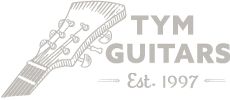1963 Guyatone LG55W
Share
When you surround yourself with guitars from one country you quickly start to see design ideas and construction methods that show up on multiple brands across different price points. No country more so than Japan in the 60's.
Most of the "big players" worked together in an attempt to design and produce higher quality guitars for better prices. They shared ideas, designs and hardware in an attempt to keep improving the product quickly and efficiently. You rarely see this in other manufacturing lines in other countries.
As the boom hit guitar factories (and brands) opened up in huge numbers, but in '63 there still wasn't a lot to choose from. Guyatone and Teisco had the domestic market tied up but with new brands popping up quickly they had a fight on their hands. Brands like Zen On, Pleasant, brands made by Teisco Gen Gakki, Kawai and of course guitars made by Fujigen and Matsumoku for many brand names.
Around this time these entry level Japanese guitars were mostly constructed like this Guyatone here, which, is one of the biggest selling entry level Japanese guitars ever made. This model in it's three forms, the 55 (one pickup), the 55W (two pickups) and the 65 (two pickups with tone switch and vibrato) were a BIG seller for Guyatone. A cheap, solid timber entry level guitar was just what the masses needed to get playing and this little guitar sold like hotcakes in both Japan and in the US as a Kent model 530 Las Vegas (65) and the Kent model 531 Lido (55), and with good reason.

Within a couple of years Japan would move in leaps and bounds as far as design and quality went but even these early 60's student guitars were amazing for the money. They are at least on par with US made Harmony/Kay guitars and locally as good as a Maton Flamingo.

The solid body is small and thin, but has a great design aesthetic obviously influenced heavily by Fender. The bolt on maple neck is thick but comfortable and has a slab rosewood fretboard with a combination of block and dot markers. Slightly later models moved to the top and one bottom fretboard markers common on mid sixties Guyatone. The scale is 24.75" with no zero fret. The headstock is again, obviously Fender influenced and large. The tuners are smooth and feel great with big plastic buttons.

These pickups were only used for a year and half as Guyatone was still using goldfoils on most models and once production ramped up they went to several more common pickups that were used from the mid sixties to closing down in '69, but did pop up later in about '68 on some models (KG35) maybe due to supply. I'm a huge fan of Guyatone (and Teisco) pickups from the 60's and I would go as far to say as some of them are easily as good as some of the legendary US name pickups from this period. The Japanese manufacturers, weather they were made in house, or by electronics companies, knew exactly what they were doing and made exceptionally good electronics throughout.

The scratchplate is the typical thick aluminium as used by a few Japanese manufacturers and the rocker switches which look the same as Teisco units, are in fact different and work differently in that they cut or complete the pickup wires circuit, not send the signal to earth to turn off. The pots are small and of decent quality.
This would have had originally had a plastic floating bridge with no adjustment for intonation but, as is common (and advisable if you want play down the dusty end of the fretboard) this has been changed to a more modern adjustable one. The original bridges do come up for sale (as people remove them for this reason) and could be fitted and cover the holes from this ToM if desired, but it is much more playable with this bridge. The tailpiece is a simple string anchor with a chrome cover.

These, like most of the student level Guyatones and Teiscos went through their "cheap Japanese guitar" phase and I have owned and sold more than I can remember. With people now appreciating vintage Japanese for what it really is even these entry level versions are getting some of the love they deserve. However, they're still only worth $3-400 in good, playable condition, but it really is a lot of guitar for that considering it still does EXACTLY what it was designed and made to do, even after 55 years. A quick search of a Harmony Stratotone or Bobcat tells me that their current "price range" is around $1000 (Aus) and a Maton Flamingo (obviously rarer) could set you back twice that and this guitar is comparable in quality and sound to both of those guitars.
This one is going into the shop along with some other treats soon.









